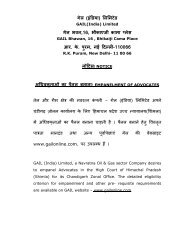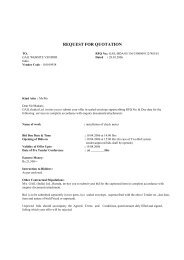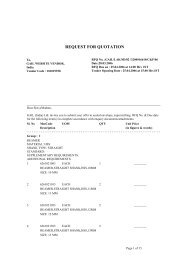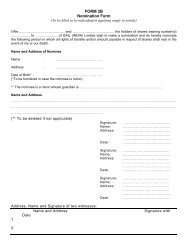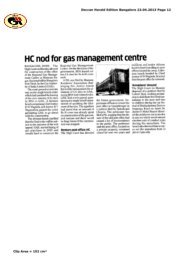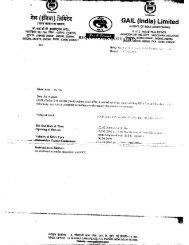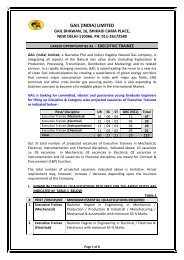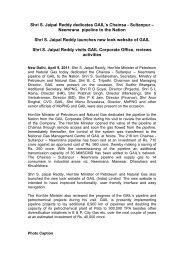GAIL (India) Limited
GAIL (India) Limited
GAIL (India) Limited
- No tags were found...
Create successful ePaper yourself
Turn your PDF publications into a flip-book with our unique Google optimized e-Paper software.
45VI.VII.VIIIIX.layer progress. Quoins shall be laid stretcher and header wise as seen on each face and shall correspond tothe arrangement of quoins in the same course.The stones shall be wetted before laying in mortar. Each masonry shall be supplied by the contractor witha vessel full of water and tumbler for wetting stones, care being taken not to spill any water on greenmasonry The bed which is to receive the stone shall be cleaned, wetted and covered with a layer freshmortar. All stone shall be laid full in mortar both in bed and vertical joints and settled carefully in placewith a wooden mallet immediately on placement and solidly bedded in mortar before it is. Clean dips andspalls carefully selected to fit in the spaces shall be wedged in to mortar joints and beds wherevernecessary to avoid thick beds or joints and beds necessary to avoid thick beds or joints of mortar Whenthe foundation masonry is laid directly on rock, the face stones of the first course shall be dressed to fitinto the rock snugly when pressed down in the mortar bedding over the rock. No dry or hollow space shallbe left anywhere in the masonry and each stone shall have all the embedded faces completely coveredwith mortar If a portion of masonry is dismantled, every stone must be found with mortar adhering fast toall its embedded surface and there shall be no hollows. This will be one of the tests in deciding if themasonry is good or bed, if need arises, where hollows or other defects are suspected a stone here or theremay be removed for confirmation. If these are confirmed such portions shall be dismantled and rebuilt atthe cost of the contractor.Face work and heating shall be brought up evently but the top of each course shall not be leveled up byuse of flat chips.No face joints shall exceed 16 mm and the same shall be struck while mortar is freshThe face joints should be properly struck while the mortar is fresh When no pointing or is to be done. Butif plastering or pointing is required to be done then joint shall be raked out when mortar is fresh.X. Stones in corners of walls and angles which are to be plastered shall be rounded. The corners shall also berounded in plaster while plastering. The frames of doors, windows, cupboards, etc., shall be housed in tothe masonry while laying the masonry only. Chisel dressing for the width of door and window frame shallbe done to obtain good fit between the frame and masonry.XI.XII.XIII.XIV.Jambs shall be made up of quoins only. Where shown to other than square, the jambs shall be splayed toconform to the drawings or the instructions of Engineer-in-charge and shall be true to the templates.Quoins of the full thickness of the wall shall be provided at the rate of 3 for each side of the door openingand 2 for each side of the window opening when the wall is 40 cm. thick or make up full thickness of thewall with break of joint of not less than 8 cm. with stones above and below.Holes of the required size and shape shall be left in the masonry during construction for fixing pipes,service lines, passage of water etc., and extra hollows loft shall be filled with 1 : 3 cement mortar of 1 : 3 :6 cement concrete and the face shall be finished with matching stones.The top of masonry on which coping, R.C.C. slab or other flooring is to be laid shall be finished level orthe required slope with stones and mortar to give an even bearing. Bed blocks of stone or R.C.C. shall bebuilt-up in the masonry under the beams.The rate of raising uncoursed rubble masonry brought up in uniform levels may be limited to a height of69 cm. per day in case of cement mortar and 45 cm. in case of lime mortar.AII masonry work shall be kept well watered for 14 days after laying.7. SPECIFICATION FOR DOORS & WINDOWS (WOOD WORK)7.1 MATERIAL7.1.1 TIMBER7.1.1.1 TEAK WOODTeakwood shall be second class <strong>India</strong>n Teakwood conforming to IS: 4021 of good quality, well seasonedand free from defects such as cracks, dead knots, sapwood etc. No individual and sound knot shall bemore than 15 sq.cm in size and the aggregate area of such knots shall not exceed 2% of the areas of thepiece. The timber shall be fairly close grained having not less than 2 growth rings per cm. Width in cross– section.




